New Options in Managing Diabetes in Samoyeds
Thank you to Cheri Hollenback for this article!
Originally printed in the Samoyed Club of America Bulletin, Summer 2022 edition
Unfortunately, Samoyeds are over-represented in the breeds afflicted with diabetes. Owners face daily challenges with diet, insulin administration and blood sugar management. Many owners find blood sugar management to be the most challenging aspect of having a diabetic Samoyed.
Home blood sugar management in humans has generally been accomplished using glucometers and "finger-sticks", where a small sample of blood is taken by poking the finger with a lancet to obtain a drop of blood. There are a number of glucometers developed for animals, including the AlphaTRAK2, iPet PRO and Test Buddy. Given our pups do not have fingers, it is recommended to obtain samples from various sites, include the dog's ear, edge of the toe pad or lip, but obtaining a sample continues to be challenging to many and uncomfortable for the dog.
Thanks in part to the work of a University of Texas researcher, continuous glucose monitoring in humans (CGM) became available in Europe in 2014. This device consists of a sensor disc that includes a very fine needle covering a thin plastic catheter that is applied to the skin with the catheter inserted into the subcutaneous tissue. The application process introduces the needle and catheter then the applicator, with the needle, is withdrawn leaving the catheter behind. The catheter allows for the sensor to continuously sample the body's blood sugar level. The technology has been continuously refined since its introduction in the United States in 2018 and some vets are now adopting it for managing diabetes in pets.
The system discussed in this article is the Freestyle Libre which I have been using on my almost 12-year-old female Samoyed, Makena, for the past five months. The sensor requires a prescription and I requested one of my veterinarians last Fall (Makena has had diabetes for the past four years), but he was unfamiliar with the technology at that time. Additional patients at the clinic also made the request, so he investigated the literature and began offering the service this spring. My veterinarian applied the first sensor, but the subsequent sensors have all been applied at home.
The application process is simple and relatively pain free for the dog. The kit is supplied with a sensor pack, a sensor applicator and two alcohol pads (Figure 1). Start the application process by clipping or shaving a small patch of fur, generally over the shoulder blade where the surface is fairly flat. (Figure 2) Cleanse the skin with the alcohol pads provided and let it dry completely. Applying a small amount of surgical glue to the adhesive portion of the sensor disc can help maintain the sensor in place for the full two weeks but it is important not to use too much so that removal is not a painful process for the dog.
Figure 1. Package with sensor applicator (left), sensor pack (right), and alcohol wipes
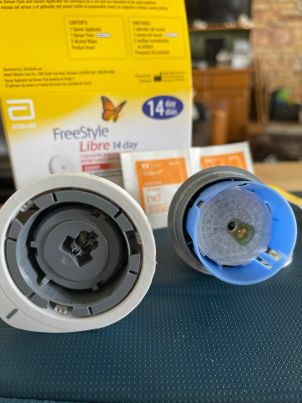
Figure 2. Application site after 2 week application
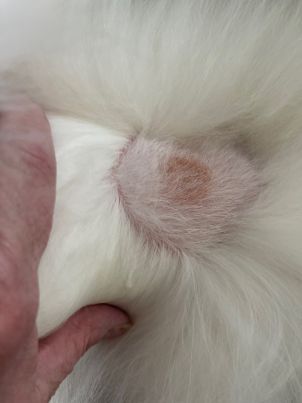
The sensor pack is spring-loaded and you activate the spring by inserting it into the applicator unit and applying pressure until it clicks. Once loaded, apply the sensor pack to selected site and press down firmly. The unit will snap as the spring is released, inserting the needle and catheter into the dog's tissue and affixing the sensor disc to the skin. It is important to hold the applicator firmly in place during this process. Once the unit has placed the sensor, lift the applicator straight up and off.
Figure 3. Sensor Disc top
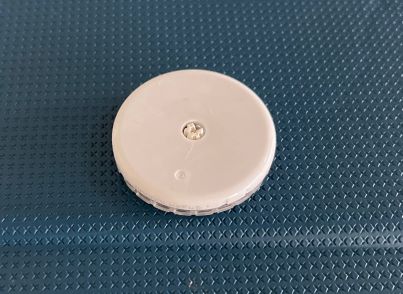
Figure 4. Patient side of sensor
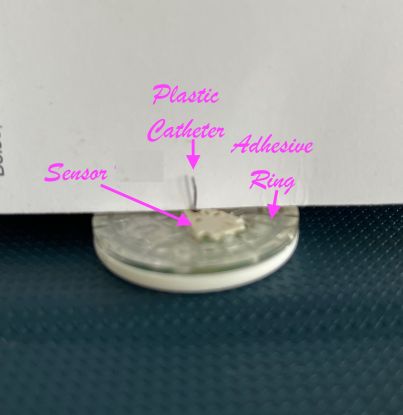
The sensor is scanned with an app on the phone to determine blood sugar. Both iPhone and Android apps are available, as well as a separate scanner that can be purchased. To activate the sensor, place the phone near the sensor and select the "scan now" icon. (Figure 5) The sensor will start reporting results in one hour. It is important to verify the accuracy of the sensor by performing a simultaneous fingerstick with the reading to assure the validity of the results.
Figure 5. Time in Target report for 7 days and "scan now" icon
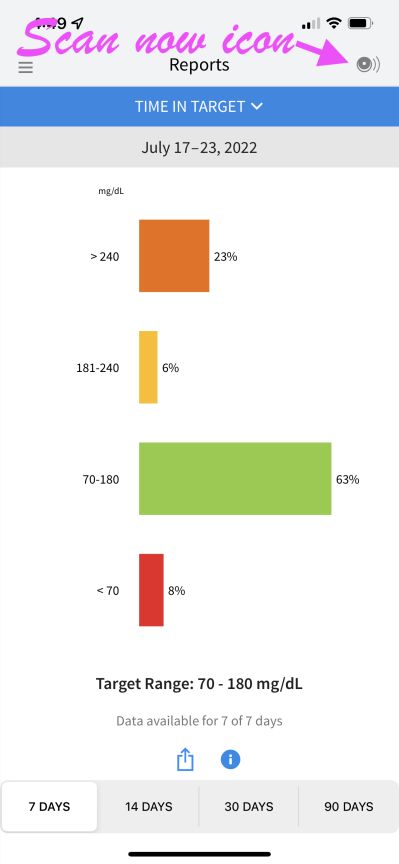
The sensor needs to be scanned every eight hours to collect the blood sugar data for that interval. If there is a longer interval between scans, there will be lost data (Figure 6). The Freestyle Libre 2 offers the option of setting high and low alarms, urgent low glucose alarm and a signal loss alarm. Cost of the sensor ranges between $40 to $60, and they need to be replaced every 14 days. Occasionally the sensors will fail and quit working during that two-week period due to being dislodged or other failures, so they may need to be replaced early. Although it does not appear any of the on-line pet prescription companies currently offer the CGM units, they may be available to COSTCO members at a reduced fee, particularly if you purchase multiple units.
Figure 6. Daily graph with missing data from 10:00pm to 1:30 am
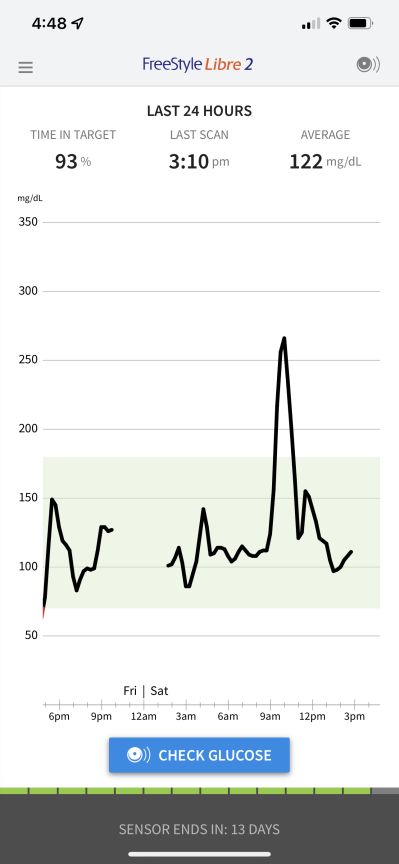
One of the greatest values in using the sensor is the trending of blood sugar levels over the day and seeing how the dog's blood sugar responds to meals, exercise and insulin dosage. Working with your veterinarian, these data allow you to fine tune diabetes care for your dog.